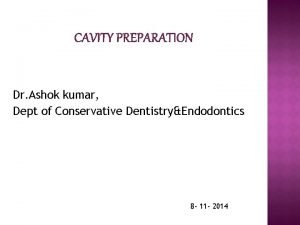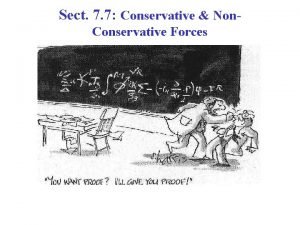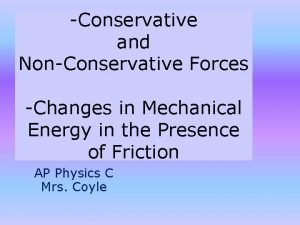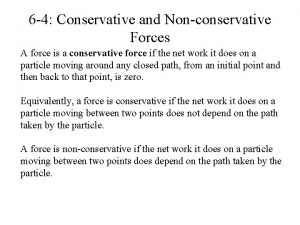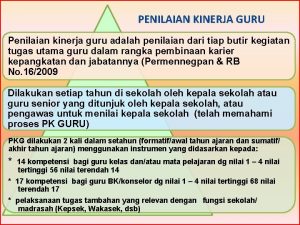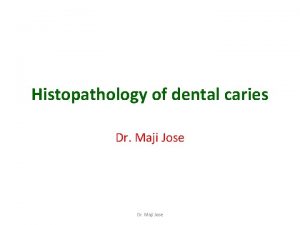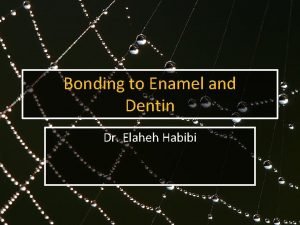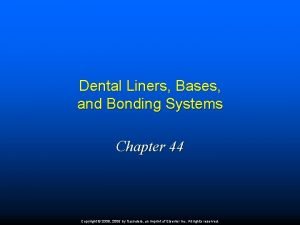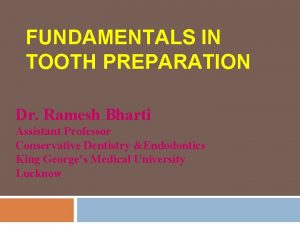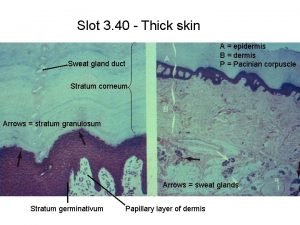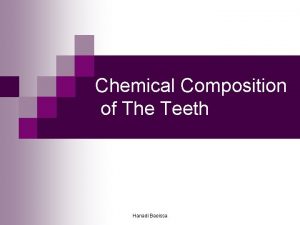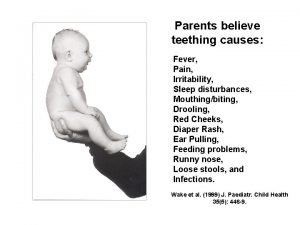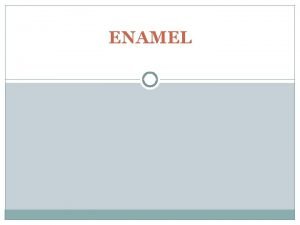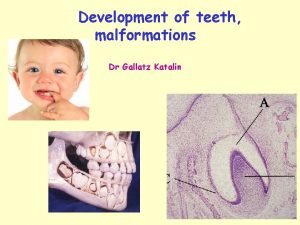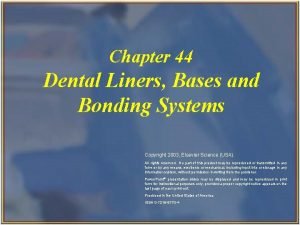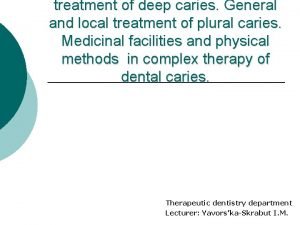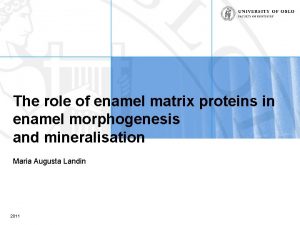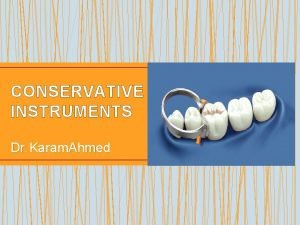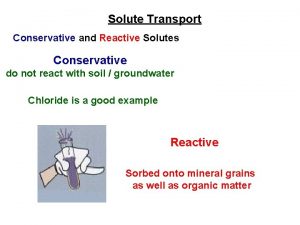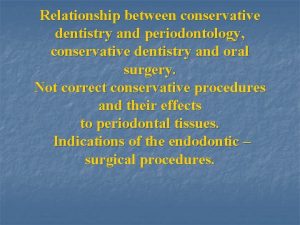ENAMEL Dr Hisham I Wali M Sc Conservative








































- Slides: 40

ENAMEL Dr. Hisham I. Wali M. Sc. Conservative Oct 202019 1

Slides 38 & 39 are not required 2

Teeth are composed of enamel, the pulp– dentin complex, and cementum Dentino-enamel Junction (DEJ) pulp dentin enamel 3

Enamel Formation Amelogenesis Ameloblasts Embryonic germ layer known as ECTODERM The ameloblasts, are lost as the tooth erupts into the oral cavity, and hence enamel cannot renew itself Enamel covers the anatomic crown of the tooth Thickness of enamel • Varies from tooth to another Incisal edges of incisors 2 mm Cusps of premolars 2. 3 -2. 5 mm Cusps of molars 2. 5 -3 mm • Varies in the same tooth from one place to another Thickness decreases gradually from cusps or incisal edges to cemento-enamel junction. 4

Thickness of enamel The enamel is thicker in the palatal surfaces of maxillary molars and in the buccal surfaces of mandibular molars. WHY? As these are supporting cusps, it is suggested that the increased thickness in these areas may be viewed as an adaptation to functional demands. 5

Chemical composition of enamel Inorganic crystalline lattice Hydroxyapatite crystals 90 -92% by volume Organic matrix Water 4 -12% Proteins 1 -2% 6

Structural composition of enamel Millions of rods or prisms Head Tail Rod sheath Inter rod substance In transverse sections, enamel rods appear as Key hole shaped , paddle shaped or fish scales. 7

Model indicating packing of keyhole-shaped rods in human enamel. Various patterns can be produced by changing plane of sectioning. 8

Number of rods ≈5 Millions ≈12 Millions DEJ Mandibular incisors Molars The rods are densely packed and intertwined in a wavy course, and each extends from the Dentino-enamel junction (DEJ) to the external surface of the tooth An ameloblast is responsible of the formation of one rod Enamel Rods 9

Alignment of enamel rods • The rods are aligned perpendicularly to the DEJ and the tooth surface in the primary and permanent dentitions except in the cervical region of permanent teeth, where they are oriented outward in a slightly apical direction. 10

Diameter of enamel rods Near the dentinal borders the diameter is about 4 μm and about 8 μm near the outer surface of enamel. This difference accommodates the larger outer surface of the enamel crown compared with the dentinal surface at the DEJ. 11

Physical properties of enamel Color Enamel is translucent in nature. Color of tooth mainly depends upon three factors: 1. Color of underlying dentin 2. Thickness of enamel 3. Amount of stains in enamel. Translucency of enamel is directly related to the degree of mineralization and homogenicity. Anomalies occurring during developmental and mineralization stage, antibiotic usage and excess fluoride intake, affect the color of the tooth. 12

Physical properties of enamel Color The white color of deciduous teeth in comparison to permanent teeth is due the opacity of their enamel covering The yellowish tinge in permanent teeth is due to the translucency and thinness of enamel in addition to color and thickness of underlying dentin 13

Physical properties of enamel Hardness Enamel is the hardest tissue of the body Hardness can vary over the external tooth surface according to the location; also, it decreases inwardly, with hardness lowest at the DEJ. The density of enamel also decreases from the surface to the DEJ 14

Physical properties of enamel Enamel is a rigid structure that is both strong and brittle (high elastic modulus, high compressive strength, and low tensile strength) and requires a dentin support to withstand masticatory forces. Dentin is a more flexible substance that is strong and resilient (low elastic modulus, high compressive strength, and high tensile strength), which essentially increases the fracture toughness of the more superficial enamel Enamel rods that lack dentin support because of caries or improper preparation design are easily fractured away from neighboring rods. For optimal strength in tooth preparation, all enamel rods should be supported by dentin 15

Undermined enamel should be removed when preparing cavities in posterior teeth If the supportive layer of dentin is destroyed by caries or improper cavity preparation, the unsupported enamel fractures easily. 16

Diagram of course of enamel rods in molar in relation to cavity preparation. 1 and 2 indicate wrong preparation of cavity margins. 3 and 4 indicate correct preparation. 17

Crystalline Component of Enamel Human enamel is composed of rods that, in transverse section, have a rounded head or body section and a tail section, forming a repetitive series of interlocking prisms. The rounded head portion of each prism (5 μm wide) lies between the narrow tail portions (5 μm long) of two adjacent prisms Generally, the rounded head portion is oriented in the incisal or occlusal direction; the tail section is oriented cervically. B T 18

Crystalline Component of Enamel The structural components of the enamel prism are millions of small, elongated apatite crystallites that vary in size and shape. The crystallites are tightly packed in a distinct pattern of orientation that gives strength and structural identity to the enamel prisms. The long axis of the apatite crystallites within the central region of the head (body) is aligned almost parallel to the rod long axis, and the crystallites incline with increasing angles (65 degrees) to the prism axis in the tail region. 19

Drawing of keyhole pattern of human enamel indicating orientation of apatite crystals within individual rods. Crystals are oriented parallel to long axes of “bodies” of rods and fan out at an angle of approximately 65 degrees in “tails” of rods. 20

Dentino-enamel junction DEJ The interface of enamel and dentin (dentino-enamel junction, or DEJ) is scalloped or wavy in outline, with the crest of the waves penetrating toward enamel The rounded projections of enamel fit into the shallow depressions of dentin. This interdigitation may contribute to the firm attachment between dentin and enamel. Enamel Dentin DEJ 21

Structural Features of Enamel DEJ & initial formation Structural features Appositional growth Changes in rod orientation Tooth surface 22

Structural Features of Enamel spindle DEJ & initial formation Enamel tufts Enamel Lamella 23

Structural Features of Enamel Structures associated with DEJ & initial formation 1. Enamel spindles are extensions of dentinal tubules that pass through the junction into enamel during its initial stage of formation. They may serve as pain receptors, explaining the enamel sensitivity experienced by some patients during tooth preparation. 24

Structural Features of Enamel Structures associated with DEJ & initial formation 2. Enamel Tufts • So called because they are similar to tufts of grass • Originate from DEJ & extend to 1/3 -1/2 the thickness of enamel • Rich in protein & represent areas of weakness of enamel • Have no clinical significance 25

Structural Features of Enamel lamella 3. Enamel Lamellae and cracks DEJ Enamel • Hypominerilized areas of enamel that extend to considerable distances in it • Represent significant weaknesses of enamel make enamel susceptible to cracking and Dentinal part of enamel lamella Dentin • Lamellae are formed as a result of failure of maturation process of enamel • They contain water & enamel matrix remnants • Lamellae are commonly found at the base of occlusal pits and fissures 26

Structural Features of Enamel DEJ & initial formation Structural features Appositional growth Changes in rod orientation Tooth surface 27

Structural Features of Enamel Those related to appositional growth Cross Striation Appositional growth Striae of Retzius 28

Structural Features of Enamel Those related to appositional growth 1. Cross striation Areas of cyclical variation in organic &/or mineral content or density of the enamel rod 2. Striae of Retzius Can be considered as growth rings Result from variations in structure and mineralization 29

Structural Features of Enamel DEJ & initial formation Structural features Appositional growth Changes in rod orientation Tooth surface 30

Structural Features of Enamel Those related to the change of rod orientation Gnarled enamel Change in rod orientation Hunter-Shreger bands 31

Structural Features of Enamel Those related to the change of rod orientation 1. Gnarled enamel Occurs as a result of twisting of enamel rods about one another through their wavy course Present in cusps of molars Strengthen enamel making it more resistant to fracture 32

Structural Features of Enamel Those related to the change of rod orientation 2. Hunter-Shreger bands They are seen in ground section of enamel as alternating curved light & dark bands extending from DEJ to enamel surface They are seen as a result to the way in which sectioned enamel rods reflect light Dark bands represent cross sectioned rods while lighter band represent longitudinally sectioned rods. 33

Structural Features of Enamel DEJ & initial formation Structural features Appositional growth Changes in rod orientation Tooth surface 34

Structural Features of Enamel Those related to Surface of tooth Developmental coatings Related to tooth surface Acquired coatings 35

Structural Features of Enamel Those related to tooth surface Acquired coatings Salivary pellicle A thin film of organic material consisting of salivary proteins such as mucoproteins & sialoproteins Salivary pellicle is converted to dental plaque by the embedment of microorganisms in the pellicle Dental plaque if not removed and when acidogenic will result in dental caries and periodontal diseases Dental plaque in turn when become calcified will change in to calculus or tarter 36

Solubility of enamel (Demineralization of enamel) Enamel is soluble when exposed to an acid medium, but the dissolution is not uniform Solubility of enamel increases from the enamel surface to the DEJ. WHY? Because the density of enamel also decreases from the surface to the DEJ Demineralization of enamel Pathological process i. e. Bacteria Intentional i. e. Application of acid for acid etching 37

Demineralization of enamel has a very important clinical implication which is: ACID ETCHING OF ENAMEL By acid etching, dentist can gain micro holes or empty space inside enamel called enamel tags Dentists make use of these tags by filling them with bonding agent (Adhesive ) before filling teeth with composite materials Acid etching After etching Scanning electron micrograph (SEM) of ename etched with 35% phosphoric acid for 15 seconds. 40

Demineralization of enamel Pathological process i. e. Bacteria Intentional i. e. Application of acid for acid etching Can we reverse pathological demineralization ? By the application of topical &/or intake of systemic fluoride the acid sensitive apatite crystals are converted to fluorapatite crystals which are more resistant to acid attack 41

THE END 42
 Dovetail shape in cavity preparation
Dovetail shape in cavity preparation Examples of conservative forces
Examples of conservative forces Force conservative et non conservative
Force conservative et non conservative Force conservative et non conservative
Force conservative et non conservative The force of gravitation is conservative or nonconservative
The force of gravitation is conservative or nonconservative Dr. hisham khalil
Dr. hisham khalil Penilaian dupak dan bukti fisik
Penilaian dupak dan bukti fisik Struktur wali kelas
Struktur wali kelas Szkocja patron
Szkocja patron Patronem szkocji jest
Patronem szkocji jest Gelanggang tok wali
Gelanggang tok wali Flaga szkocji i walii
Flaga szkocji i walii Angka kredit wali kelas
Angka kredit wali kelas Objectives of operative dentistry
Objectives of operative dentistry Peranan wali sanga adalah
Peranan wali sanga adalah Baba wali qandhari
Baba wali qandhari Dupak kepala sekolah
Dupak kepala sekolah Anovulation who classification
Anovulation who classification Letak kerajaan demak
Letak kerajaan demak Susunan wali mujbir
Susunan wali mujbir Transverse clefts dentin
Transverse clefts dentin Wet bonding vs dry bonding
Wet bonding vs dry bonding An example of an enamel bonding procedure is
An example of an enamel bonding procedure is Cervical enamel projection
Cervical enamel projection Dej dentistry
Dej dentistry Class 4 cavity preparation walls
Class 4 cavity preparation walls Initial tooth preparation stage
Initial tooth preparation stage Enamel pulp
Enamel pulp Enamel composition
Enamel composition Enamel defect
Enamel defect Cementogenesis
Cementogenesis Coloboma labii
Coloboma labii Types of enamel lamellae
Types of enamel lamellae Inlay wax definition
Inlay wax definition Tooth development
Tooth development Non cutting meaning
Non cutting meaning Enamel rods in gingival third of primary teeth
Enamel rods in gingival third of primary teeth Base and liner in dentistry
Base and liner in dentistry Enamel organ
Enamel organ Zinc amalgam is an alloy of
Zinc amalgam is an alloy of Enamel spindle
Enamel spindle
